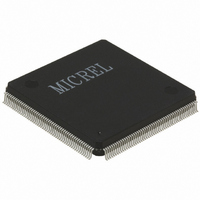KS8999 Micrel Inc, KS8999 Datasheet - Page 26

KS8999
Manufacturer Part Number
KS8999
Description
IC SWITCH 10/100 9PORT 208PQFP
Manufacturer
Micrel Inc
Specifications of KS8999
Applications
*
Mounting Type
Surface Mount
Package / Case
208-MQFP, 208-PQFP
Fiber Support
Yes
Integrated Led Drivers
Yes
Phy/transceiver Interface
MII/SNI
Power Supply Type
Analog/Digital
Package Type
PQFP
Data Rate (typ)
10/100Mbps
Vlan Support
Yes
Operating Temperature (max)
70C
Operating Temperature (min)
0C
Mounting
Surface Mount
Jtag Support
No
Operating Temperature Classification
Commercial
Lead Free Status / RoHS Status
Contains lead / RoHS non-compliant
For Use With
576-1023 - BOARD EVAL EXPERIMENT FOR KS8999
Lead Free Status / RoHS Status
Not Compliant, Contains lead / RoHS non-compliant
Available stocks
Company
Part Number
Manufacturer
Quantity
Price
Part Number:
KS8999
Manufacturer:
PRX
Quantity:
20 000
January 2005
Micrel, Inc.
is Priority Control Scheme (register 2 bits 2-3) which controls the interleaving of high and low priority frames. Options
allow from a 2:1 ratio up to a setting that sends all the high priority first. This setting controls all ports globally.
Another global feature is Priority Buffer Reserve (register 2 bit 1). If this is set, there is a 6KB (10%) buffer dedicated
to high priority traffic, otherwise if cleared the buffer is shared between all traffic.
On an individual port basis there are controls that enable DSCP, 802.1p, port based and high/low priority queues.
These are contained in registers 4-12 bits 5-3 and 0. It should be noted that there is a special pin that generally
enables the 802.1p priority for all ports (pin 91). When this pin is active (high) all ports will have the 802.1p priority
enabled unless specifically disabled by EEPROM programming (bit 4 of registers 4-12). Default high priority is a
value greater than 4 in the VLAN tag with low priority being 3 or less.
The table below briefly summarizes priority features. For more detailed settings see the EEPROM register
description.
VLAN Operation
The VLAN’s are setup by programming the VLAN Mask Registers in the EEPROM. The perspective of the VLAN is
from the input port and which output ports it sees directly through the switch. For example if port 1 only participated in
a VLAN with ports 2 and 9 then one would set bits 0 and 7 in register 13 (Port 1 VLAN Mask Register). Note that
different ports can be setup independently. An example of this would be where a router is connected to port 9 and
each of the other ports would work autonomously. In this configuration ports 1 through 8 would only set the mask for
port 9 and port 9 would set the mask for ports1 through 8. In this way, the router could see all ports and each of the
other individual ports would only communicate with the router.
All multicast and broadcast frames adhere to the VLAN configuration. Unicast frame treatment is a function of
register 2 bit 0. If this bit is set then unicast frames only see ports within their VLAN. If this bit is cleared unicast
frames can traverse VLAN’s.
VLAN tags can be added or removed on a per port basis. Further, there are provisions to specify the tag value to be
inserted on a per port basis.
Register(s)
40-47
4-12
4-12
4-12
4-12
2
2
3
Bit(s)
3-2
7-0
7-0
1
0
5
4
3
Global/Port
Global
Global
Global
Global
Port
Port
Port
Port
Description
General
Priority Control Scheme: Transmit buffer high/low interleave control
Priority Buffer Reserve: Reserves 6KB of the buffer for high priority traffic
Enable Port Queue Split: Splits the transmit queue on the desired port for high and low
priority traffic
DSCP Priority
Enable Port DSCP: Looks at DSCP field in IP header to decide high or low priority
DSCP Priority Points: Fully decoded 64 bit register used to determine priority from
DSCP field (6 bits) in the IP header
802.1p Priority
Enable Port 802.1p Priority: Uses the 802.1p priority tag (3 bits) to determine frame
priority
Priority Classification: Determines which tag values have high priority
Per Port Priority
Enable Port Priority: Determines which ports have high or low priority traffic
Table 3. Priority Control
26
KS8999
KS8999












